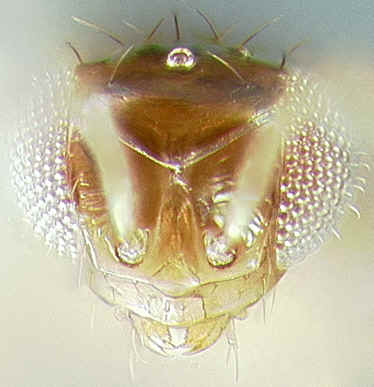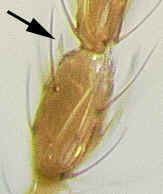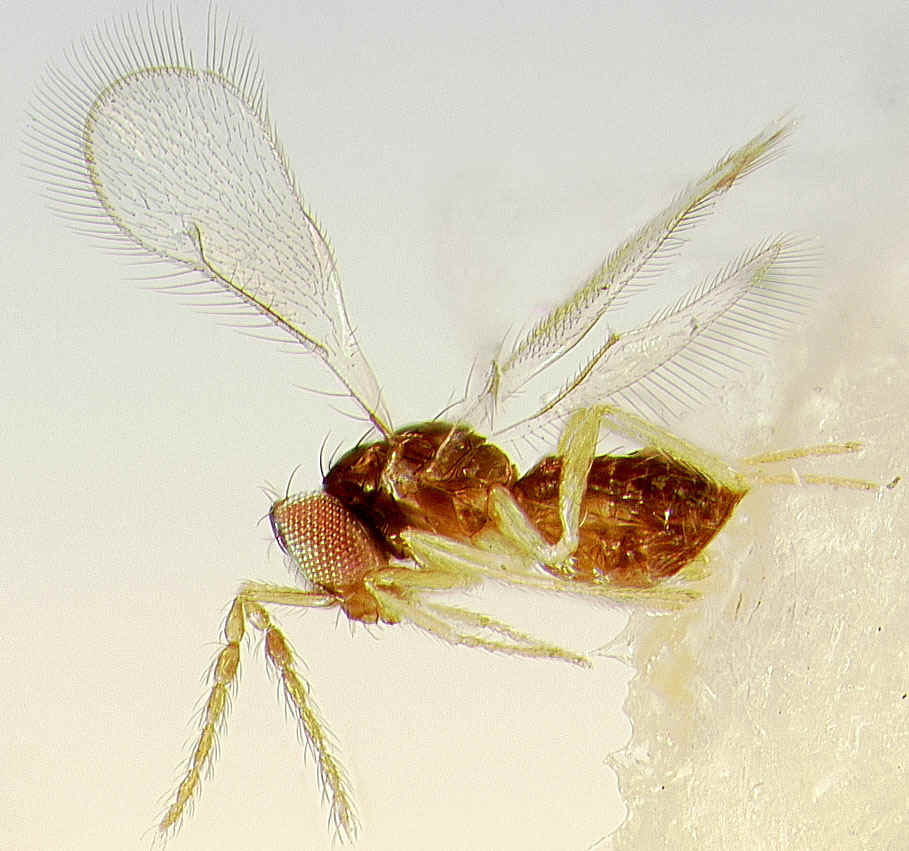

1a-b: Perditorulus face (left), and funicular segment with peg sensilla indicated (right)
return to: Eul 1 Eul 4 eud 1 eul 1 ent 1 ent 5 ent 10 ent 13 ent 16 ent 21 ent 26
Perditorulus
Hansson, 1996 comparative info return to: prev home
Body unusually small (<1mm). Mandibular formula 3:3, never exodont.
Clypeus set off by distinct sutures. Transverse frontal groove weakly to strongly
v-shaped; scrobal depressions uniting at transverse groove or reaching transverse groove
separately. Occipital margin never carinate. Flagellar formula 2,4,1; heads
of flagellar peg sensilla always elongate, spear-shaped (type
3); flagellar setae long, often arranged in whorls in males; placoid sensilla present
along most of the ventral margin of scape in males; pedicel about 3x longer than broad.
Mesosomal dorsum weakly sculpted, with relatively long setae (also on vertex);
pronotum not or hardly visible dorsally; mesoscutal midlobe with 2 pairs of long setae;
transepimeral sulcus weakly curved, arching dorsad. Forewing relatively narrow, sometimes
with broad fuscate band posterior to marginal vein; postmarginal vein 0.3-0.7x stigmal
vein length; no setal tracks radiating from stigma; radial cell bare or setose; speculum
small, always closed posteriorly; apical fringe setae relatively long. Propodeum very
short, smooth, without median carina; callus with 2 setae; petiolar foramen often
large, rendering propodeum strongly emarginate posteriorly.
Petiole always much broader than long and not sculpted. Male genitalia without
volsellar setae, but sometimes with paired "parameral" setae in which
one pair is indistinguishable from volsellar setae; parameres often elongate or
sinuate (especially helpful in species with ambiguously placed
"parameral" setae). Color always dark with weak metallic tinge. Compare with: Omphale,
Closterocerus.


1a-b: Perditorulus face (left), and funicular segment with peg
sensilla indicated (right)
2a-b: P. bidenticulatus Hansson male genitalia (left), and P.
longiparameratus Hansson male genitalia (p=paramere) (right)

3: Perditorulus
Biology:
Comments: Many described species. Obviously very similar to Omphale, and requires slide-mounting of males to reliably distinguish from that genus. This genus is very similar in some characters (lack of volsellar setae, type 3 sensilla) to the extralimital genus Tropicharis, but differs from it in many other ways.
Comparative information:
Omphale: Male genitalia with volsellar setae that are usually conspicuously enlarged and flattened; parameres indistinct, never elongate. Body length usually >1mm. Mandibles exodont in a few species. Flagellar peg sensilla often L-shaped, greatly elongate in only a few species. Head and mesosomal dorsum usually without long setae. Forewing often without elongate fringe setae. Only the male genitalic characters are 100% reliable for distinguishing this genus from Perditorulus.
Closterocerus: Clypeus usually not set off by distinct sutures (but often with faint lateral sutures). Male genitalia with volsellar setae. Flagellar peg sensilla L-shaped, not greatly elongate. Forewing often without elongate fringe setae. Some species with only 1 pair of setae on mesoscutal midlobe.
References
Hansson, C. 1996a. Taxonomic revision of the Nearctic species of Omphale Haliday (Hymenoptera: Eulophidae). Entomologica Scandinavica supplement 49.
Hansson, C. 1996b. A new genus of Eulophidae (Hymenoptera: Chalcidoidea) with remarkable male genitalia. Systematic Entomology. 21: 39-62.
Image credits: 2a-b: Hansson (1996b)